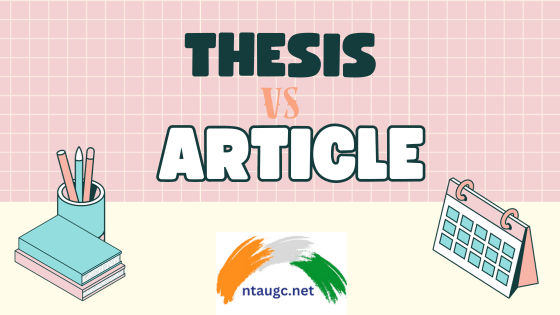A thesis and an article are both written documents that serve different purposes within the realm of academia and research. While they share some commonalities, they are distinct in their objectives, structure, length, and intended audience. Here’s a more detailed exploration of the differences between a thesis and an article:
Thesis:
- Primarily serves an educational purpose, showcasing a person’s depth of knowledge and research skills.
- Generally longer in length, often spanning tens of thousands of words.
- Audience includes educational committees and professors who assess the work for awarding a degree.
- Structure is comprehensive, encompassing sections like introduction, literature review, methodology, results, discussion, conclusions, etc.
- Provides a detailed interpretation of research findings and outcomes.
- References tend to be exhaustive, including a comprehensive list of sources.
- Appendices are often included and may be mandatory.

Article:
- Aimed at disseminating information and contributing to existing knowledge.
- Generally shorter in length compared to a thesis, usually spanning a few thousand words.
- Audience includes a broader readership, such as researchers, professionals, and the general public.
- Structure is concise, often focusing on key points and omitting extensive sections.
- Emphasizes clear and concise presentation of outcomes or findings.
- References are more selective, including relevant sources.
- Appendices, if included, are typically optional and used to provide additional information.

Difference Between a Thesis and an Article
Purpose:
- Thesis: A thesis primarily serves an educational purpose. It represents the culmination of an individual’s academic journey, demonstrating their depth of knowledge, research skills, and ability to contribute original insights to their field of study.
- Article: An article, on the other hand, is intended for the broader dissemination of knowledge. It aims to contribute to existing knowledge within a particular area by presenting new findings, insights, or perspectives to the academic community and beyond.
Length:
- Thesis: Theses are usually lengthy documents that delve extensively into the chosen research topic. They can span tens of thousands of words, encompassing multiple chapters that systematically explore various aspects of the subject.
- Article: Articles are relatively shorter in comparison, typically ranging from a few thousand to several thousand words. Their brevity is conducive to the quick consumption of information.
Audience:
- Thesis: The primary audience for a thesis includes academic committees, professors, and experts in the field. Their evaluation determines the awarding of an academic degree, making the thesis an educational assessment.
- Article: Articles are written for a wider readership, including researchers, professionals, students, and the general public who are interested in the subject matter. They contribute to the ongoing discourse in the field.
Structure:
- Thesis: Theses follow a comprehensive and structured format, often including sections such as introduction, literature review, methodology, results, discussion, conclusions, and recommendations. The goal is to present a well-rounded exploration of the research topic.
- Article: Articles emphasize concise communication. They typically include essential sections like an introduction, methodology, results, and discussion, with the focus on delivering key insights efficiently.
Interpretation of Results:
- Thesis: Theses provide an in-depth interpretation of research findings. The emphasis is on thorough analysis and exploration of the implications of the results within the broader context of the field.
- Article: Articles focus on a clear and concise presentation of research outcomes. The discussion of results is succinct and to the point, providing readers with a quick understanding of the findings.
References and Citations:
- Thesis: Theses often include exhaustive lists of references, citing a wide range of sources to establish the depth of research and knowledge.
- Article: Articles tend to include more selective references, focusing on key sources that directly support the presented findings.
Appendices:
- Thesis: Appendices in theses are commonly included to provide supplementary materials that contribute to a comprehensive understanding of the research.
- Article: Appendices, if present, are usually optional and used sparingly to offer additional details that enhance the main content.
Difference Between a Thesis and an Article












